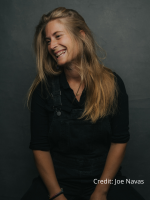My friend Nicole Cormier is a registered dietician and studying for a masters in herbalism. And when she told me she eats pine pollen — and that in fact, it’s one of her favorite things to forage, I had to tag along.
"So what we’re doing here is we are harvesting the catkins, which is the male reproductive structure. This time of year I’ll go right up to the clusters and do a flick, that one’s not ready so you didn’t see any, but if we go up here, there you go, you’re going to see this really nice cloud."
The cloud is bright yellow, almost green — the stuff we all see in the spring all over our cars and decks and anything left outside. And like most of you I’ve always seen this pollen as something of a giant nuisance, but Nicole tells me it’s actually a pretty amazing medicinal food.
"A lot of times people will use pine pollen medicinally for hormonal vitality — and because it has androgens in it, like testosterone and DHEA."
DHEA or dehydroepiandrosterone is a hormone that’s basically a precursor in our bodies to estrogen and testosterone. We produce it naturally but production decreases as we age, and pine pollen can be a helpful anti-aging boost. You don’t want to eat pine pollen if you’re pregnant or on hormone therapy treatments, Nicole says, but otherwise, it’s a five-star health food.
"And it also has tons of phytochemicals in it which makes it immune modulating, really good for our immune system. It has amino acids in it. So some of the essential amino acids, it's a complete protein, so great to put that powder right into your smoothies."
I looked up the health benefits of pine pollen, and there are plenty of studies backing Nicole’s claims. Pine pollen is especially big in China where it’s been used medicinally for centuries, and it has a long list of demonstrated health benefits — antioxidant, anti-inflammatory, antiviral, antimicrobial, antitumor, anticancer, anti-aging, — the list goes on. And in case you’re thinking ugh, but I’m allergic! Apparently, it’s good for that too.
"So we would think that we wouldn't go near pine pollen if we had allergies this time of year. However, another popular reason to use it is to desensitize us to our allergies."
This is best done by starting small and then working our way up to eating more. But first we have to harvest the pine pollen, which starts by snipping the loaded male catkins off the tips of low lying branches into a paper bag.
" Some people will take a big bag and put it over the branches and shake shake shake shake shake shake shake and let all of the powder shake off. It's not my preferable practice," explains Nicole.
I asked her, "Why?"
"I just like snipping the clusters and collecting them. And then in my experience of harvesting them, after I snip them and lay them out on parchment paper and really let them dry in a dry, cool place, I get a lot more out of it versus just shaking what's on the tree."
It’s kind of like letting a green banana sit on the counter and ripen. Once the catkins are dry they open up more and Nicole sifts the pollen out from the rest of the debris and starts using it. She told me she hasn’t gotten too creative yet with how she eats pine pollen — she mostly makes it into tinctures or blends it into smoothies or sprinkles it on top of oatmeal. But there are recipes online for pine pollen pancakes and pasta sauce and truffles and cookies — and no matter how you use it, Nicole says, it’s tasty: silky and sweet.
—
Find recipes using pine pollen here.
Take a look at studies on the nutritional benefits of pine pollen here.











